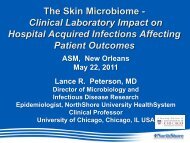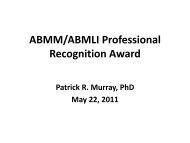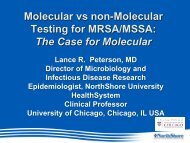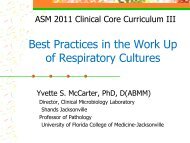The Tell-Tale Stain
The Tell-Tale Stain
The Tell-Tale Stain
Create successful ePaper yourself
Turn your PDF publications into a flip-book with our unique Google optimized e-Paper software.
111 th General Meeting ASM<br />
New Orleans, LA<br />
May 24<br />
Session 242 3:00 – 5:30 PM<br />
Certify Your Worth: ABMM Credentialing
EVEN MORE
1. I am extremely knowledgeable. (I should be<br />
up there talking.)<br />
2. Better than average. (But compared to this<br />
crowd… way, way above average.)<br />
3. I am here with a ―friend‖.<br />
(He/she promised to buy the drinks later.)<br />
4. I think Donald Trump Gram-stained the nation
Edgar Allen Poe<br />
Author of the ―<strong>Tell</strong>-<strong>Tale</strong> Heart ―<br />
and ―<strong>The</strong> Raven‖, etc.<br />
Jill E. Clarridge, III, Ph.D., D(ABMM), F(AAM)<br />
Professor, University of Washington<br />
Chief, Microbiology, Serology and Molecular<br />
Diagnostics , VA Med Center<br />
Seattle WA
Modified GMS <strong>Stain</strong><br />
Once upon a silver staining,<br />
Oh, be sure I’m not complaining,<br />
Saw I numerous rods and cocci<br />
as I had never seen before.
<strong>The</strong> Modified Gomori Methenamine-Silver Nitrate<br />
<strong>Stain</strong> (GMS <strong>Stain</strong>) will aid in the histological<br />
visualization of which of following?<br />
1. Fungi including Pneumocystis carinii<br />
2. Nocardia asteroides<br />
3. Mycobacteria<br />
4. Corynebacteria<br />
5. Treponema pallidum<br />
6. All of above and others
Case A 28 year old female with chronic hepatitis B<br />
with 2-3 year history of rash and lesions was referred to<br />
dermatology for biopsy.<br />
HISTORY OF PRESENT ILLNESS:<br />
• the rash started on her extremities as<br />
tender, dark nodules which then<br />
progress to become flat, darker lesions<br />
which finally develop into scars.<br />
• the rash (most) eventually resolved<br />
spontaneously.
She reports history of tick bites in Missouri, which she<br />
thought caused several of the nodules on her right leg.<br />
A biopsy was performed<br />
Cultures were negative.<br />
Rare AFB seen by<br />
tissue AF stain<br />
Granulomas seen<br />
Special stains for bacteria, fungi and<br />
AFB were reported negative except<br />
for GMS.
FURTHER HISTORY<br />
Patient has associated symptoms of<br />
peripheral neuropathy, swelling in hands and feet,<br />
"bone pain", joint pain,<br />
hair loss on head and body.<br />
She reports the hand and foot pain and swelling are worsened<br />
by cold weather. <strong>The</strong> joint pain is localized to knees, wrists and<br />
hands.<br />
She reports chemical exposure to hydraulic fluid but this has<br />
only been in last 1 month.<br />
Hypopigmented area with loss of<br />
sensation on abdomen<br />
She reports travel to her birthplace<br />
of Palau, most recently in 2007.
What is the diagnosis for this patient?<br />
1. Rocky Mountain Spotted Fever<br />
2. Erythema Induratum of Bazin<br />
3. Leprosy (Hansen’s Disease)<br />
4. Syphilis
Erythema Induratum of Bazin :<br />
It is an inflammation in the subcutaneous fatty tissue and that is<br />
caused by a cellular immune response to M. tuberculosis .<br />
It usually involves the lower extremities.<br />
<strong>The</strong> diagnosis is made on the basis of histopathology and tests<br />
showing a positive cellular immune response to TB.<br />
Tiny case –somewhat related to main case<br />
• A woman with a two-year history of non-healing leg ulcers<br />
Her PPD was positive
She was started on anti-tuberculous chemotherapy.<br />
Four months later lesions were healing.<br />
<strong>The</strong> biopsy showed vasculitis and tuberculoid granulomas<br />
Special stains for bacteria, fungi and AFB were negative.<br />
Cultures were negative<br />
M. tuberculosis PCR can support the diagnosis, but a negative<br />
PCR result does not exclude EIB.
What do you think is the etiological agent of leprosy?<br />
<br />
1. This is like asking who is buried in Grant’s tomb!<br />
2. Mycobacteria leprae<br />
3. Mycobacteria lepromatosis
For this case it is Mycobacteria leprae.<br />
16S rRNA gene sequencing was positive for M. leprae<br />
Dendrogram showing<br />
the relatedness of the<br />
16S rRNA gene<br />
sequences of selected<br />
Mycobacteria<br />
But what is Mycobacteria lepromatosis
New Mycobacterium species from 2 patients who died of diffuse<br />
lepromatous leprosy (DLL).<br />
DNA extraction from heavily infected freshly frozen liver tissue or<br />
paraffin-embedded skin tissue<br />
Six genes of the organism were sequenced.<br />
Significant genetic differences with M. leprae were found, including a<br />
2.1% divergence of the 16S ribosomal RNA (rRNA) gene,<br />
<strong>The</strong> unique clinicopathologic features of DLL led them to propose<br />
Mycobacterium lepromatosis sp nov.
Historically the varying clinical presentations has been thought to<br />
be primarily due to host response<br />
Borderline Indeterminate Lepromatous<br />
New species might explain varying severity and clinical features of<br />
HD.<br />
This has been challenged –M. lepromatosis could be just another<br />
related Mycobacteria-not causing leprosy.<br />
However, the sequence has also been detected in another leprosy<br />
patient
Hansen’s Disease Factoids<br />
Worldwide— about 250,000 new cases/year<br />
United States – 150 new cases/year<br />
<strong>The</strong> largest numbers of cases in the United States are in California,<br />
Texas, Hawaii, Louisiana, Florida; New York and Puerto Rico.<br />
Most are in immigrants from countries where the disease is endemic.<br />
What is the source of the about 50 cases acquired in the US?
Hansen’s Disease Factoids<br />
Mycobacterium leprae multiplies very slowly (generation time 12.5<br />
days) and is an obligate intracellular parasite.<br />
It grows best at 27ºC to 33ºC, which correlates with its affecting<br />
cooler areas of the body like the skin nerve segments close to the<br />
skin, and the mucous membranes of the upper respiratory tract.<br />
M. leprae has never been cultured in artificial media but grows in the<br />
tissues of the armadillo, which has a body temperature of 34ºC.<br />
Leprosy is found in wild armadillos in the south central United States<br />
and possibly in some primates<br />
Most patients today are treated with dapsone, rifampin and<br />
clofazimine. Also levofloxacin, minocycline and clarithromycin are<br />
used in selectively<br />
Chemotherapy rapidly renders the patient noninfectious.
Which is not true?<br />
1. Mycobacterium leprae can be transmitted transplacentally.<br />
2. Leprosy is known as a sexually transmitted disease<br />
3. Kissing or eating an armadillo can be harmful to your health<br />
4. Leprosy which was brought to the New World by Europeans<br />
and Africans infected the native armadillo<br />
5. Armadillos when dead in the road are called hill-billy speed<br />
bumps.
Transmission:<br />
<strong>The</strong> exact mechanism of transmission is unclear.<br />
Leprosy is probably transmitted by droplet infection and direct<br />
contact with discharges from respiratory mucous membranes<br />
of infected persons.<br />
Household and prolonged, close contact appear to be important<br />
in transmission.<br />
In children
Handling or eating armadillos could expose<br />
humans to the bacterium that causes leprosy.<br />
Probable Zoonotic Leprosy in the Southern United States<br />
Truman, Singh, Sharma, Busso, ougemont, Paniz-Mondolfi,<br />
Kapopoulou, Brisse, Scollard, Gillis, Cole. NEJM April 28, 2011<br />
1. Genotyped about 150 strains using 51 singlenucleotide<br />
polymorphisms , an 11-bp insertion–<br />
deletion with 10 variable-number tandem repeats.<br />
2. Found local infected humans share the same<br />
leprosy bacterium strain as local armadillos.<br />
3. Humans contract the disease by handling<br />
armadillos or consuming their meat.<br />
4. More than 20 percent of armadillos around Carville<br />
infected with M. leprae<br />
5. <strong>The</strong> animals are most common in Texas, but they<br />
are expanding their range in Florida, and<br />
northward into the Midwest.
Now back to <strong>Stain</strong>ing M. leprae<br />
Skin smears (touch preps) may be taken from lesions. A biopsy<br />
should be taken from entirely within a lesion or for example, the ear<br />
lobe<br />
<strong>The</strong> effects of therapy are sometimes followed by counting the<br />
numbers of bacilli in a biopsy or smear from the patient.<br />
But what is the best stain to demonstrate Mycobacteria leprae in<br />
tissue and how should it be performed<br />
1. Routine tissue AFB stain<br />
2. Fite’s stain<br />
3. Plain old Kinyoun stain as<br />
used in the microbiology lab<br />
4. Silver stain
KINYOUN’S STAIN<br />
We obtained a slice of the<br />
tissue from the block,<br />
deparafinned it and<br />
performed our routine stain<br />
in microbiology<br />
FITE'S ACID FAST STAIN Combines<br />
peanut oil with the deparaffinizing<br />
solvent (xylene), minimizing the<br />
exposure of the bacteria's cell wall<br />
to organic solvents, thus protecting<br />
the precarious acid-fastness of the<br />
organism.
Routine tissue AFB stain Fewest AFB<br />
Fite’s stain More AFB<br />
Kinyoun stain as used micro lab About same # but darker<br />
Siver stain More organisms, not specific<br />
Thus stain method is important for<br />
quantitating to follow course of<br />
disease<br />
<strong>The</strong> exact procedure should be<br />
known as many labs tended to<br />
perform the stains in their own<br />
unique way. This so confusing
1831 - Edgar’s older brother, William, dies in<br />
Baltimore, probably of tuberculosis<br />
1836 - Edgar (aged 27) and Virginia (aged 13) marry in<br />
Richmond, Virginia.<br />
1847 - Virginia Poe dies of tuberculosis<br />
1849 – Edgar Allen Poe dies<br />
Final Question: Of what did Edgar Allen Poe die?<br />
1. Died subsequent to being mugged and falling in a puddle<br />
while in an alcoholic stupor (Competitor wrote this after he<br />
died)<br />
2. Some AFB disease (Tuberculosis or Leprosy would make<br />
sense with this talk)<br />
3. Unknown (Wikipedia)<br />
4. He did not die (Celebrity Ghost Stories)
Special thanks to colleagues<br />
From the National Hansen's Disease Programs in<br />
Baton Rouge, Louisiana, which functions as a<br />
referral and consulting center with related<br />
research and training activities:<br />
Dr. David Scollard.<br />
Dr. Richard W. Truman<br />
Dr. Thomas P. Gillis<br />
From the University of Washington and Seattle VAMC<br />
Dr. Greg Raugi<br />
Dr. Rich Miller<br />
Dr. Jeff Virgin<br />
Susan Izak<br />
Dr. Angela Talley for the<br />
erythema induratum of Bazin<br />
case
















